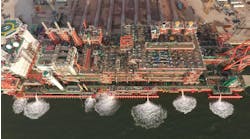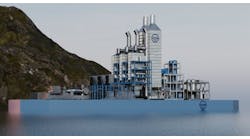Nick Terdre, Contributing Editor
Wireline products specialist Sandvik has launched an improved duplex material for use as wireline in wells with corrosive environments. SAF2205SH is a further development of SAF2205, the duplex stainless steel material being applied increasingly in medium sour, low hydrogen sulfide wells in place of the low tensile, 316 austenitic grade.
The SH in the new product’s designation stands for ‘super high’, a reference to its tensile strength, which is significantly higher than that of the standard SAF2205. This superiority varies with the dimension of the wire - 0.082-in diameter wire has a 20% higher breaking load, and 0.125-in wire a 12% higher breaking load, according to Phil Etheridge, Sandvik Materials Technology’s key-account manager for the wire product area.
The contrast with 316 wire, the standard wireline material, is even greater, he says. Up to 45% higher breaking loads have been achieved with SAF2205SH for slickline dimensions.
The new material has good corrosion resistance - its pitting resistance equivalent (PRE) value is a minimum 35, on a par with the standard SAF2205 and significantly higher than 316.
SAF2205SH is also extremely ductile, an important property in wireline applications. Sandvik performed a test in which a 0.108-in slickline with 307 kg-lb/sq in (ksi) tensile strength was wrapped 150 times around its own diameter, but no trace of surface cracking was found.
SAF2205SH is being offered as a replacement for 316 - and SAF2205 - for wireline use in medium sour environments where high mechanical strength is required. Especially compared with 316, the new material offers better lifetime economy, Etheridge says. Although it costs more, it lasts longer and can be used in a wider range of conditions.
The new material would perform well as a logging cable, he suggests. At present, logging cables are almost exclusively made from either carbon or austenitic steels. In this application the new material offers up to 70% higher breaking loads than 316, he claims. That means a smaller diameter SAF2205SH cable can be used to achieve the same breaking load as a larger diameter 316 cable.
Deep wells provide further advantages. As depth increases, more of the cable’s mechanical strength is taken up in supporting the weight of the cable itself. The rate at which the breaking load diminishes as depth increases is less for a lighter cable than for a heavier one, Etheridge points out.
High temperature trials
Sandvik has also staged tests to determine the effect of high temperatures on SAF 2205SH. After the material was heated to 600°C (1,110°F) and then cooled, a drop of about 10% in tensile strength occurred, as had been expected, but the material remained perfectly ductile. Austenitic materials were similarly heat-tested, and proved to become brittle at 270°C plus.
SAF2205SH’s performance in very high temperatures indicates its suitability for geothermal applications, in which temperatures of 250°C and above are commonly experienced. These are much higher than are normally encountered in oil and gas drilling, even in deep, high-temperature gas wells. SMT is interested in the fast-growing geothermal sector, as geothermal wells demand for a lot of instrumentation work requiring the use of wirelines.
SMT’s efforts to meet the wireline requirements of ever more demanding oil and gas wells are finding good acceptance by the industry, and the company achieved record wireline sales in 2005. In a growing wireline market, SMT is taking a larger share. Etheridge notes rapidly increasing demand for higher grade wireline materials, such as the company’s Sanicro26, a sour service austenitic wireline steel.
SMT has also logged its first sales of Sanicro36, an austenitic alloy developed for highly corrosive environments, with deliveries to both China and Mexico. As the company intended, some customers have acquired Sanicro36 as an alternative to the very high cost nickel/cobalt chrome alloys which until now have been the only wireline materials available for operations in extreme conditions.•
For more information, contact Phil Etheridge, Sandvik Materials Technology. Tel +46 2626 3120, fax +46 2627 4720, [email protected], www.smt.sandvik.com.




